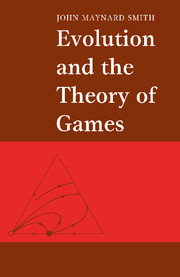Book contents
- Frontmatter
- Contents
- Preface
- 1 Introduction
- 2 The basic model
- 3 The war of attrition
- 4 Games with genetic models
- 5 Learning the ESS
- 6 Mixed strategies – I. A classification of mechanisms
- 7 Mixed strategies – II. Examples
- 8 Asymmetric games – I. Ownership
- 9 Asymmetric games – II. A classification, and some illustrative examples
- 10 Asymmetric games – III. Sex and generation games
- 11 Life history strategies and the size game
- 12 Honesty, bargaining and commitment
- 13 The evolution of cooperation
- 14 Postscript
- Appendixes
- Explanation of main terms
- References
- Subject index
- Author index
14 - Postscript
Published online by Cambridge University Press: 05 June 2012
- Frontmatter
- Contents
- Preface
- 1 Introduction
- 2 The basic model
- 3 The war of attrition
- 4 Games with genetic models
- 5 Learning the ESS
- 6 Mixed strategies – I. A classification of mechanisms
- 7 Mixed strategies – II. Examples
- 8 Asymmetric games – I. Ownership
- 9 Asymmetric games – II. A classification, and some illustrative examples
- 10 Asymmetric games – III. Sex and generation games
- 11 Life history strategies and the size game
- 12 Honesty, bargaining and commitment
- 13 The evolution of cooperation
- 14 Postscript
- Appendixes
- Explanation of main terms
- References
- Subject index
- Author index
Summary
To conclude, I will attempt to say where evolutionary game theory came from, what is its present state, and how it may develop in the future.
In origin, the concept of an ESS is highly polyphyletic. For me, it arose from an attempt to formalise some ideas of the late Dr George Price about animal contests: hence the term ‘strategy’, and a model based on pairwise contests. The idea that variable behaviour could be explained by frequency-dependent selection was proposed independently by Gadgil (1972), and Parker (1970a) had interpreted dung fly behaviour in terms of fitness equalisation. A very similar idea had arisen in the study of the evolution of the sex ratio. The original concept is Fisher's (1930). Shaw & Mohler (1953) sought an equilibrium by equalising the payoffs for producing sons and daughters, and MacArthur (1965) used techniques very similar to those in this book to find the stable sex ratio. Hamilton (1967), tackling the problem of the sex ratio in a structured population, explicitly used game-theoretic ideas; his ‘unbeatable strategy’ is essentially equivalent to an ESS. Fretwell & Lucas (1970), in their analysis of animal dispersal, used the fact that fitnesses must be equal at an equilibrium to reach the concept of an ideal free distribution. More recently, it has become apparent that Trivers' (1971) idea of reciprocal altruism is best understood as the ESS for a repeated game between the same two opponents, and Axelrod & Hamilton (1981) have taken a step towards uniting classical and evolutionary game theory by applying evolutionary concepts to the Prisoner's Dilemma.
- Type
- Chapter
- Information
- Evolution and the Theory of Games , pp. 174 - 179Publisher: Cambridge University PressPrint publication year: 1982
- 1
- Cited by



